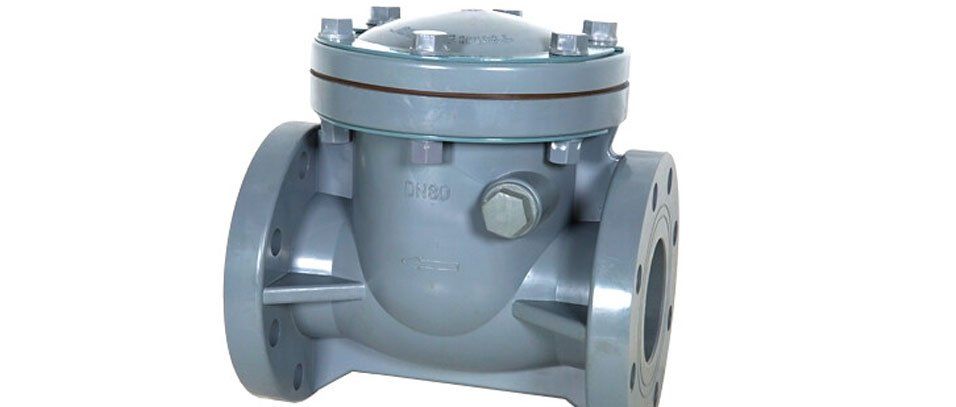Understanding the Types of Check Valves and How They Work
A check valve is a specialized piece of equipment that is designed to allow any fluids or gasses to flow in one direction. There are many different types of check valves that are designed for different uses, but every one of them will only allow fluids or gasses to enter one direction and exit the other. Fluids or gasses will continue to travel through the check valve in the same flow direction until there is pressure drop or the source is shut off.

What is a check valve? A check valve opens under a specified amount of pressure and prevents backflow. It’s a type of safety device that ensures that whatever is flowing will always flow in the correct direction. Check valves also have tight seals to prevent leakage.
Today, we’re going to dive further into how these check valves work, discuss the main types of check valves that you may encounter, and examine when these valves are used.
How Does a Check Valve Work?
There are many types of check valves to explore, each one having its own unique purpose. However, every type of check valve is designed to operate without the need for automation or even human interaction. Instead, they rely on the flow velocity of the gas or liquid to operate the valve. There is no way for someone to control these valves from the outside, meaning there is no lever or valve handle.
Check valves are designed to open with between 1 and 5 PSI, allowing for even the slightest of currents to open them. The higher the flow stream, the more open the valve will become. Most check valves have a maximum position of 85-degrees. For example, an air compressor check valve allows for air to flow in only one direction and quickly blocks the path once it is turned off, preventing air leakage.
What Are the Main Types of Check Valves?
There are several different types of check valves. Each check valve is designed to accommodate a specific industrial application. Below, we’re going to discuss the main types of check valves and what makes them unique. This is not an exhaustive list of the types of check valves available.
Swing Check Valve
A swing check valve is a full-port design that places the disk out of the way of the flow of the liquid or gas. These types of check valves are often used when there is a high percentage of solids and the equipment has a low on/off cycle.
A swing check valve has a great amount of swing distance than other types of check valves. This makes it ideal for situations in which the valve needs to close slowly. A wafer check valve is a specific type of check valve that allows for a high volume of material to pass through it when it is open. Swing valves are commonly used in the
oil and gas industry
Tilting Disk Check Valve
A tilting disk check valve has a pivot point located at the center of the disk. The unique design forces the fluid or gas to flow over both the top and bottom of the disk. This is useful in situations where there is frequent flow reversal. A tilting disk check valve typically has a low-pressure drop when used with low flow rates, and a higher pressure drop when used with high flow rates.
Ball Check Valve
Instead of using a disk, this type of check valve makes use of a ball to control the flow of liquid. Ball check valves are typically spring-loaded to help keep the ball in the correct position. When there is enough water pressure being pushed through the valve, the ball is moved out of the way and the material is able to flow. As the pressure decreases, the ball is pushed down and back in the closing position.
Where Are Check Valves Used?
What is a check valve used for? Ever since they were created, they’ve been used to help control backflow problems that can occur in a variety of industries. You can safely say that an industry that calls for moving liquid or gases through a pipe will have check valves put in place to help control flow.
Some of the more common uses of check valves seen throughout many industries are:
Pumps: Check valves are absolutely essential for pumps and are one of the most common uses. In a single pump system, the check valve will help control the flow from the suction tank, blocking the flow from reversing when the pump stops. In parallel pump systems, check valves prevent the duty pump from pumping materials into the standby pump. A sump pump check valve is vital for keeping the water flowing in the correct direction.- Pharmaceutical: Manufacturing pharmaceuticals is heavily reliant on moving liquids. Using check valves allows manufacturers to regulate the fluid’s flow for efficiency, production, and quality. Check valves can be found at many stages in the pharmaceutical manufacturing process.
- Heating Boiler: Check valves are essential for heating boilers as they keep hot water from circulating when it is not called for. Furthermore, these important valves prevent water from returning to the boiler, which would cause excessive pressure. In residential settings, check valves prevent hot water from entering the general water supply and impacting drinking or cooking water.
- Other industrial applications where check valves are used include air conditioning systems and hydraulic systems—to name a few.
Check Valves Are A Necessity: Explore Your Options With GN
Check valves are present in most industries and every building. They are a required component in any system that needs to control the flow of gas or liquids.
Since check valves do not require any complex automation or human interaction, they are an ideal way to create complex systems to control the flow of materials.
Are you looking to source high-quality check valves for your business and its projects? Want to work with a tier-1 supplier?
Get in touch with GN today to learn more about the
GN 4.0 difference.






